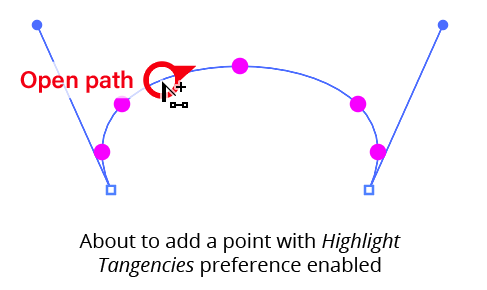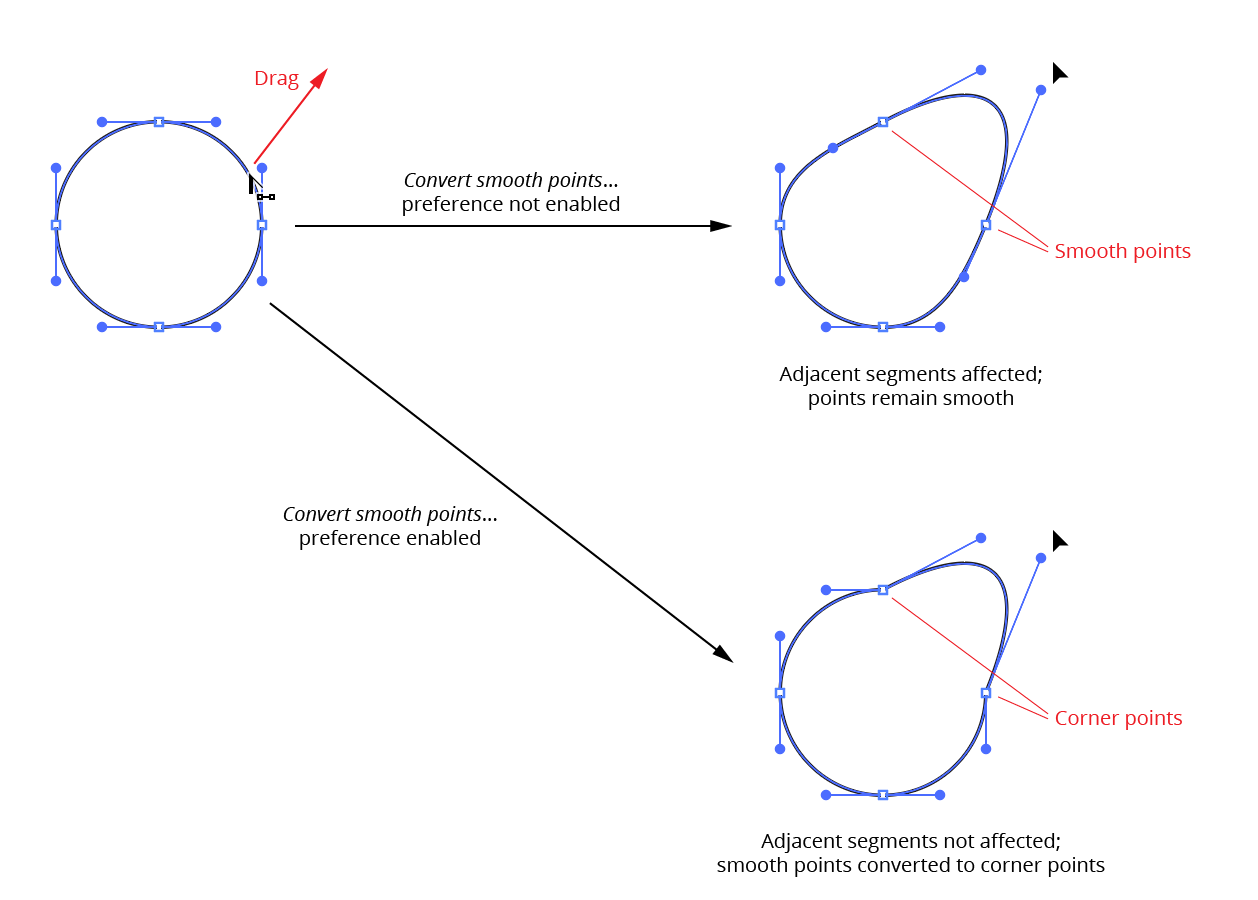 Path Segment Operations
Path Segment Operations
Clicking
Clicking on a path segment without any modifier keys selects it, causing its handles (in handle at one end, out handle at the other end) to become visible (if they exist), and hiding other handles on the same path. Other paths are not affected: if they were fully- or partially-selected, they remain so. Marqueeing over a segment acts in the same way as clicking on it.
If the Show All Handles on Selected Paths preference is enabled, clicking on a path segment selects all of the segments on the path (thus causing their handles to become visible).
Adding one more modifier keys while clicking a path segment changes or adds functionality:
Shift: As with a point,
Shift-clickingon a path segment will, by default, simply add or remove the path segment from the selection (unless the Show All Handles on Selected Paths preference is enabled, in which caseShift-clickingdoes nothing). However, by enabling the preference Shift-Clicking Equalizes Handle Lengths, it instead equalizes the path segment’s handle lengths (handle angles are not affected). How the length is calculated depends on where you click along the length of the segment.Shift-clickingin the middle third will average the handle’s lengths together, whileShift-clickingin either of the outer thirds will change the length of the nearest handle to match the opposite one:

PathScribe Shift-clicking on path will add or remove segment from selection
Option/Alt: By default,
Option/Alt-clickingon a path segment will add a new smooth point to the path at the clicked point. The cursor shows a “plus” sign. If the preference Snap to Tangencies is enabled, the cursor will snap to vertical, horizontal and diagonal tangencies on the path segment (the constrain angle is honored). A red guide will appear when the cursor is snapping to show you the tangent direction:

PathScribe path add point
Additionally, you can choose to highlight all of the tangencies on the current path segment with a small magenta dot by enabling the Highlight Tangencies preference:

PathScribe add point highlight tangencies on the current path
If the Option/Alt-Clicking Adds New Point to Path preference is disabled, then Option/Alt-clicking a path selects all of the path’s segments, thereby making all of the handles on the entire path visible. You can do this even while in Multi-Handle Mode. Other paths are not affected.
Shift+Option/Alt: By default,
Shift+Option/Alt-clickingon a path segment toggles the visibility state of all the handles on the entire path. If a path has only some of its handles visible,Shift+Option/Alt-clickingon the path will hide them. However, by enabling the preference Shift-Clicking Equalizes Handle Lengths, it instead will retract or extend new handles. If the handle nearest the click exists, both handles will be retracted; otherwise, new handles are created where they don’t already exist. In both cases, adjacent path segments are not affected.

PathScribe Shift+Option-clicking on path toggles visibility state
Dragging
Dragging a path segment reshapes it, similarly to the Direct Selection tool. The closer the initial mouse-down is to one point, the more that point’s handle movement is affected by the cursor movement and the less the other handle is affected. Starting the drag midway along the path between the points affects both handles equally. If the Keep Path Under Cursor When Dragging preference is disabled, handles are still moved relative to the initial click location, but the path will not necessarily pass through the cursor position.
If either of the segment’s handles does not exist at the start of the drag, new ones will be created. Their initial location is controlled by PathScribe’s Smoothing Ratio preference.
Normally, adjacent segments will also be affected when you drag a segment if its endpoints are smooth points, since the opposing handles must change angles to remain 180° away from the moved handles. If you’d rather only affect the dragged segment in isolation, you can enable the preference Convert Smooth Points to Corner Points When Dragging Path Segments:

PathScribe Path drag break
This preference can also be changed on the fly by pressing the D key.
Note: When you are using Recognize Connector Points, segments with connector points at one or both ends are affected differently by drags, since a connector point can have only one handle at a fixed angle; see Connector Points).
While dragging, there are various keys which can be pressed to perform additional functions:
Shift: Reshapes the path segment while keeping it symmetric. Symmetric means that both handles are of the same length and are at the same angle to the imaginary line running through the endpoints of the path segment.
Shift-draggingfrom the middle third of a path segment will additionally constrain the handle angle to be perpendicular to this imaginary line:

PathScribe path drag symmetrical handles
Except for middle-third Shift-dragging, if you release the Shift key (or if you started dragging without it) and later hold it down, the curve will become symmetric using the lengths and angles of the handles as they exist at that moment.
Option/Alt: Constrains the angles of the handles to their original values (±180°). If you have the Option/ Alt-Clicking Adds New Point to Path preference enabled, you must hold down
Option/Altafter you hold down the mouse button, or you will inadvertently add a point to the path. But even if you begin to drag withoutOption/Alt, holding it down afterwards will reset the angles of the handles to the angles they had when you originally moused down on the path. Note: If the initial mouse-down was close to one of the ends of the segment, the segment shape will probably be very sensitive to movement of the cursor. You can gain better control of the final segment shape by using slow-drag in this situation.Shift+Option/Alt:
Shift+Option/Alt-dragginga path segment reshapes it with the following constraints: the handle lengths are kept equalized, and the handle angles are constrained to their original values. As withOption/Alt-dragging, handle angles will be set to the original angles unlessShiftwas held down by itself first (which will have made the curve symmetric). This allows you to first symmetrize a curve until the handles are at the angle you like, and then lengthen or shorten them without losing the symmetry. WhenShiftandOption/Altare both held down before you drag, neither the Shift-clicking Equalizes Handle Lengths nor the Option/Alt-Clicking Adds New Point to Path preferences apply.D: Toggles the current Convert Smooth Points to Corner Points When Dragging Path Segments preference. The preference reverts to its original value when the mouse button is released.
R: Retracts the handles of the path segment being dragged.
S: Immediately converts the path segments endpoints to smooth type points.
T: Enables “Tangent constraining.” In this mode, the angle of the path segment as it passes through the cursor position is kept constant, regardless of where the cursor is dragged. To achieve this, the segment’s handles are adjusted in a different manner from a normal drag.
